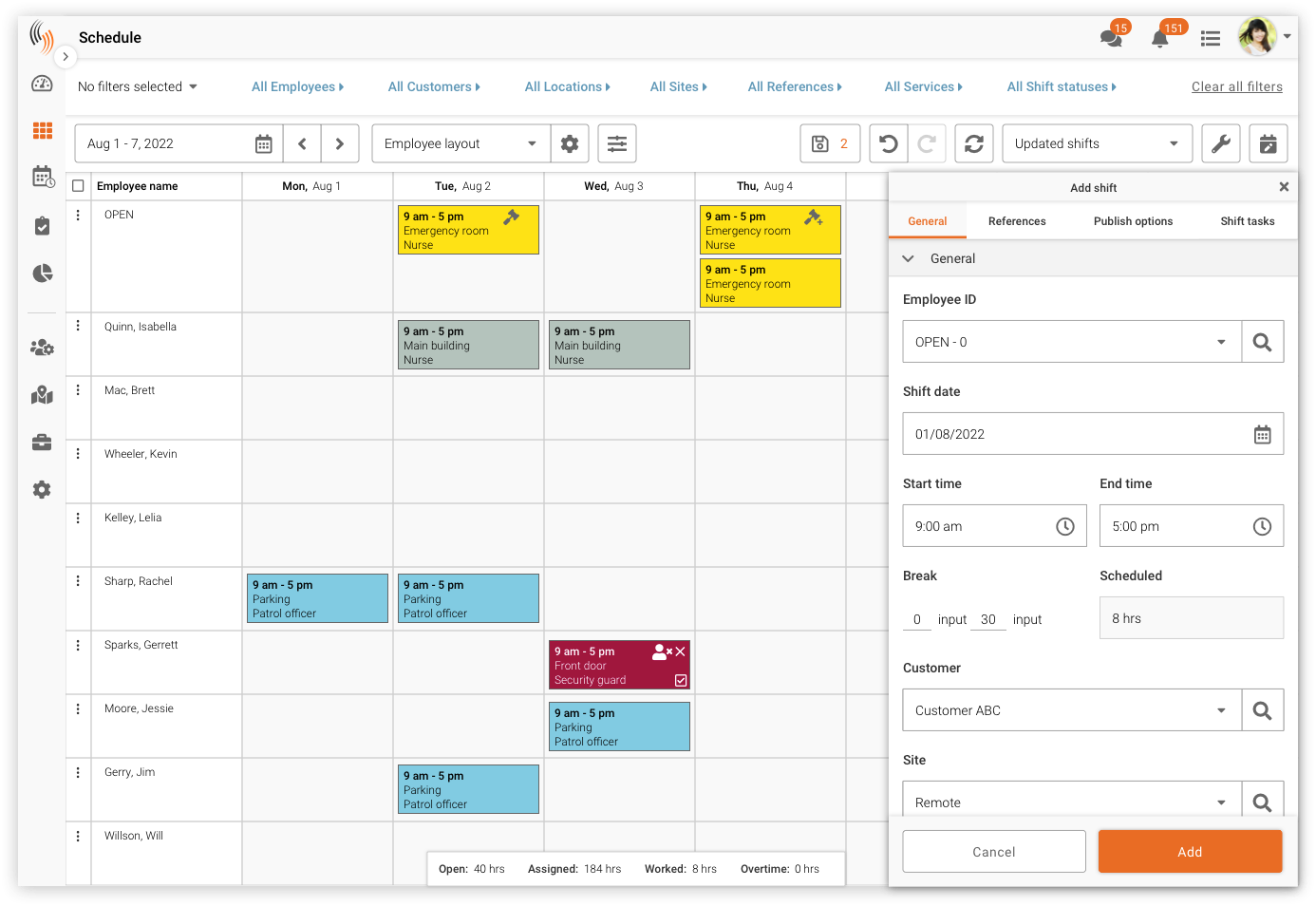Employee Scheduling is the act of assigning or designating people for a fixed time in a schedule. It is a fundamental function that involves simple problems — usually lots of them. When done correctly, employee scheduling can help you reduce costs and improve service!
Too often employee scheduling is all about putting out fires, and never having time to be proactive. Without the right tools, low-cost employee scheduling is almost impossible to achieve, even for the smallest companies. And this is true whether you’re providing a product or service – so listen up!
How does Scheduling affect Costs?
An average of 70% of a company’s costs relate to the workforce in one way or another. Managers now realize that they should view employee scheduling as more than just a cost; it is the most critical investment area of all. It is also an opportunity to reduce costs through effective scheduling.
Who is available?
How do I pay less?
Am I giving people enough rest so the staff will do an adequate job the next day?
Am I carrying too many employees? Too few?
Am I paying out too much overtime?
These are the questions a manager starts with. The list goes on. A good employee scheduling solution helps with more than just covering tasks for the company.
How does Scheduling affect Service?
Good customer service is essential for any successful business, right? And secondary to that, customer retention is what sets the great apart from the mediocre.
- Employee scheduling is intrinsically difficult to solve because of situational issues.
- New employees start one week.
- Experienced employees are absent the next.
- Sites close. Customers cancel contracts.
- Some employees are sick the following week.
There are many potential issues that can make it difficult to find an affordable way to plan schedules for different situations. These issues are caused by various disruptions that can occur.
Over time, we notice a clear pattern and understand that managing this important function is difficult without proper tools. So, what can schedulers do to make life easier and drive customer loyalty?
Employee Scheduling Software – an investment
When the company incurs extra overtime charges because of limited employee scheduling tools, the financial consequences are obvious. In fact, a good employee scheduling solution is an investment that pays off in the short, mid, and long-term. Beyond reducing and controlling costs, it can increase productivity, improve employee retention, and therefore, enhance future revenue. A secondary benefit of all of the above, is being able to provide great customer service!
Employee scheduling is the mainstay of workforce management. Investment firm Sanford C. Bernstein & Co. reported that using workforce management tools can help lower labor costs while improving customer service. Not surprisingly, it is predicted that the adoption of workforce management systems will increase.
The Knock-On Effects of Flaws
The financial impacts of an inefficient schedule are felt throughout the entire organization. The problems that stem from an inadequate scheduling solution extend far beyond overtime costs or time wasted performing manual scheduling and re-scheduling. Let’s look at how:
Situation: Unfilled or Understaffed Shifts
When your operation has unfilled or understaffed shifts, you might excperience;
- Cancelled contracts
- Lost revenue from unfulfilled work
- Decreased production
- Employee burnout, which can lead to high absenteeism and attrition. As we all know, this causes increased payroll and training costs.
Situation: Systemic Overtime Shifts
A lot of organizations don’t realise the reliance they have on overtime – which is costly! Here’s how;
- Increased payroll costs
- Subsequent lack of staffing flexibility
Situation: Unqualified or Competence Mismatch
Without the right resources and knowledge when it comes to scheduling, managers often schedule employees for shifts/roles that they are not best-suited for. This leads to;
- Unfilled contractual obligations to customers – which can lead to the cancellation of current or future costs
- Lowered productivity and poor service
Situation: Lack of Compliance with Business Rules
Most business have a list of business rules that should be considered when building a shift schedule. These might be union based, budget based, or simply a professional preference. Here’s what can happen if those rules aren’t adhered to;
- Difficulty enforcing union, customer or government regulations
- Excess scheduling manpower costs
- Increases costs from penalties and/or audits
- Schedule goes over budget, requiring the reallocation of organizational revenue
- Increased planning costs
- Schedule is under budget, leading to a potential loss of revenue
So, now you might be starting to see exactly how efficient employee scheduling can affect your bottom line, and your performance as a business. Let’s take a look at the tools you can try, and how they will help!
Types of Solutions on the Market
The need for scheduling is common to all companies and has led to specialized providers. The problems of scheduling employees are fundamentally different from, say, hotel room usage, or factory processing. To reflect this, scheduling systems generally fall within Employee, Resource or Production categories. They are further specialized to suit specific vertical markets.
No two companies are alike. Therefore, each company brings different system requirements to the table. Buyers must shop for solutions designed to fit within their market category, opting for features that give them the visibility and functionality that matches their specific set of problems.
Prioritizing Features
Within their industry category, buyers need to consider the features they want, given their budgetary restrictions. The system’s suitability depends on factors like staff size, regulations, and schedule flexibility. The complexity of the schedule can impact how well the system works.
For example, a large staff size may make the system less suitable. Strict regulations can also affect the system’s effectiveness. Additionally, a schedule that changes frequently can pose challenges for the system.
So, if you research multiple vendors, you might get bogged down, but we recommend focusing on the features you think you will need. As a basic starting point, here is a list of features a scheduling system that most organizations require:
- Flexible, configurable views into the problem that suit your line of work
- Ease of use
- Automated payroll data capture and cost forecasting
- Ability to quickly adjust employee levels to reflect changes in demand
- Ability to easily assign and remove shifts from rosters
- Qualifications tracking & enforcement for team members
- Automated rule checking and alerts
- Automation of routine communications
- Allowance accrual tracking
- Elimination of pay & compensation errors
- Integration with external systems
- Real time updates based on actual time and attendance
The right scheduling system will enable a manageable solution. As a result, companies will experience lower labor costs and be in a position to provide excellent customer service. Think about it, if right members of your team are in the right place at the right time for your customers – you’ll have happy customers, loyal customers and ultimately – greater customer satisfaction. Pair that with cost savings, and you have a winning formula.
Providing familiar views of relevant problems, user-friendly tools that can solve them, and time-saving automation is a key investment in operational integrity.
If you’d like to hear more about how Celayix can help you reduce costs from day 1, request a cost-benefit analysis here! One of our Solution Advisors will reach out and talk you through everything.








